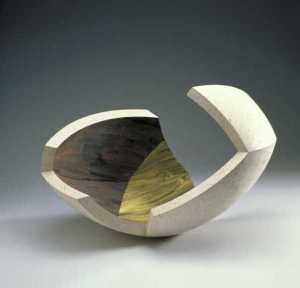The English ceramist Martin Smith did not make use of any traditional accessories, such as a wheel or mould, for this work, preferring instead cutting and sanding machines. He sawed and sanded a white ceramic sphere into four segments, which he then glued together into a new creation. The inside is painted with engobes (coloured in clay silt).

Specifications
| Title | sculpture |
|---|---|
| Material and technique | Earthenware, engobe |
| Object type |
Sculpture
> Three-dimensional object
> Art object
|
| Location | This object is in storage |
| Dimensions |
Height 27,4 cm Length 42,6 cm |
|---|---|
| Artists |
Ceramist:
Martin Smith
|
| Accession number | A 6222 (KN&V) |
| Credits | Purchased 1986 |
| Department | Applied Arts & Design |
| Acquisition date | 1986 |
| Creation date | in 1986 |
| Internal exhibitions |
Martin Smith (1996) |
| Material | |
| Object | |
| Geographical origin | England > Great Britian > United Kingdom > Northern Europe > Europe |
| Place of manufacture | London > England > Great Britian > United Kingdom > Northern Europe > Europe |
























